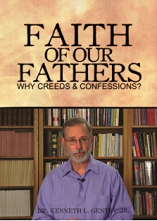THE SONS OF GOD IN GENESIS 6 (1)
[image error]PMW 2018-035 by Kenneth L. Gentry, Jr.
The episode occurring in Gen. 6:1–4 is quite difficult to interpret and has been the subject of much debate. Though there are several interpretations of this passage, historically two views have dominated the debate: (1) the angelic offspring view and (2) the human seed-line view.
Though the seed-line view is the traditional Christian understanding, perhaps the oldest view in extra-biblical antiquity is the angel-human interpretation. It is found as far back as 200 B.C. in the non-biblical book of 1 Enoch (6:11–7:6) as well as in the first-century book by Josephus called Antiquities (1:3:1). This view holds that fallen angels came down to earth and engaged in sexual relations with women who then bore giants as their offspring.
The seed-line view holds that the godly line of Seth (Gen. 4:25) that has been the focus of Genesis since Gen. 5:3 is beginning to intermarry with unbelieving women (“whomever they chose” without reference to their faith. These women would be largely represented by the Cainite line (Gen. 4:17ff). This appears to be the proper interpretation due to its fitting the context and avoiding bizarre results.
[image error]
As It Is Written: The Genesis Account Literal or Literary?
Book by Ken Gentry
Presents the exegetical evidence for Six-day Creation and against the Framework Hypothesis.
See more study materials at: www.KennethGentry.com
The angel view presented
The angel interpretation is based on the following main lines of evidence:
(1) The “sons of God” is a reference to angels, as we can see in Job 1:6; 2:1; 38:7. Thus, this designation can easily apply to angels.
(2) The word nephilim (Gen. 6:4) signifies giants, which may be the case in Num. 13:33. This term, though debated, can fit this presentation in Genesis 6.
(3) Passages such as 1 Pet. 3:19–20; 2 Pet. 2:4; and Jude 6–7 support this interpretation. Advocates of the angel-view of the “sons of God,” find what they believe to be confirmation of their view in these three NT passages.
Thus, there is apparent biblical warrant for this interpretation. Nevertheless, the evidence for this angelic interpretation is unpersuasive for the following reasons.
The angel view evaluated
(1) The concept “sons of God” can certainly mean angels, but it can also refer to God’s people (Exo. 13:15; Jer. 3:19; Gal. 3:26; see further discussion below). Besides, Genesis has not mentioned angels to this point, so that their sudden appearance would be surprising. But in the final analysis, the beings in Gen. 6 could not be fallen angels and associates of Satan, for they would not be called “sons of God.”
[image error]Consider the Lilies
A Plea for Creational Theology
by T. M. Moore
Moore calls us to examine the biblical doctrine of general revelation from the perspective of what he calls creational theology. In this artful introduction to creational theology, Moore helps us develop the skills and disciplines for doing theology as we look upon and interact with the world around us.
See more study materials at: www.KennethGentry.com
(2) The word “Nephilim”(a rare term occurring only three times in Scripture) literally means “fallen ones” and can therefore apply to notorious sinners. Its verbal form (“fall”) occurs scores of times suggesting its ethical meaning.
(3) The New Testament passages do not mention any cohabitation of angels with women, and certainly not their marrying them. 1 Pet. 3:19 does not mention angels, but is referring to the evil men in Noah’s day. The other two New Testament passages refer back to the original fall of angels, not something that occurs later in Gen. 6.
(4) The fact of giants being mentioned in the context of the Nephilim does not help the argument. We see other giants in the Bible, such as the Emim (Deut. 2:10–11), the Zamzummim (Deut. 2:20–21), king Og of Bashan (Deut. 3:11), Goliath (1 Sam. 17:4–7), and more, yet no one claims that they were the offspring of angels.
The following additional problems arise for the angelic view:
(1) Jesus teaches that angels do not marry (Matt. 22:30; Mark 12:25), though Gen. 6:2 speaks of these “sons of God” taking wives (cp. Gen. 4:19; 11:29; 12:19; 31:50). Gen. 6 is not speaking of fornication, but of settled marriage. Only in this one difficult passage in Scripture do we have anything suggesting angels marrying humans.
(2) Angels are a different order of being in that they are spiritual beings (Heb. 1:14). When they assumed visible, tangible form they would do so only for a time and surely would not possess human DNA allowing for procreation while dwelling on the earth.
(3) In Gen. 6 God’s judgment is directed against men, not the alleged angels (Gen. 6:3, 5–6, 13).
Thus, it appears that the angel-food does not have a sure footing in Scripture. But what about the human seed-line view? I will deal with that in my next article.
Click on the following images for more information on these studies:



Kenneth L. Gentry Jr.'s Blog
- Kenneth L. Gentry Jr.'s profile
- 85 followers



